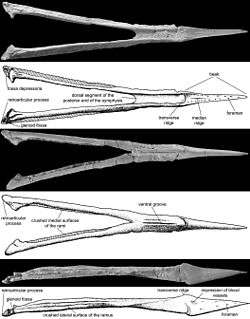Bakonydraco
| Bakonydraco Temporal range: Late Cretaceous, Santonian | |
|---|---|
 | |
| Holotype fossil | |
| Scientific classification | |
| Kingdom: | Animalia |
| Phylum: | Chordata |
| Class: | Reptilia |
| Order: | †Pterosauria |
| Suborder: | †Pterodactyloidea |
| Family: | †Tapejaridae |
| Tribe: | †Tapejarini |
| Genus: | †Bakonydraco Ősi, Weishampel & Jianu, 2005 |
| Species: | †B. galaczi |
| Binomial name | |
| Bakonydraco galaczi Ősi, Weishampel & Jianu, 2005 | |
Bakonydraco is a genus of pterodactyloid pterosaur of the Santonian-age Upper Cretaceous Csehbánya Formation of the Bakony Mountains, Iharkút, Veszprém, western Hungary.
The genus was named in 2005 by David Weishampel, Attila Ősi and Jianu Coralia. The type species is Bakonydraco galaczi. The genus name refers to the Bakony Mountains and to Latin draco, "dragon". The specific epithet galaczi honors Professor András Galácz, who helped the authors in the Iharkút Research Program, where fossils are since 2000 found in open-pit mining of bauxite, among them the remains of pterosaurs, the first ever discovered in Hungary.
Description

Bakonydraco is based on holotype MTM Gyn/3, a nearly complete mandibula, a fusion of the lower jaws. Also assigned to it, as paratype, is MTM Gyn/4, 21: parts from another jaw's symphysis (the front parts, having fused into a single blade-like structure, of the two lower jaws); azhdarchid wing bones and neck vertebrae from the same area may also belong to it.[1]
The lower jaws are toothless and the two halves of the mandibula are frontally fused for about half of its overall length, forming a long, pointed section that is compressed side-to-side and also expanded vertically, giving it a somewhat spearhead- or arrowhead-like shape from the side. This expansion occurs both on the lower edge and on the top surface, where the most extreme point corresponds with a transverse ridge which separates the straight back half of the symphysis from the pointed end in the front. The jaws of MTM Gyn/3 are 29 centimeters long (11.4 inches), and the wingspan of the genus is estimated to be 3.5 to 4 meters (11.5 to 13.1 feet), which is medium-sized for a pterosaur. Because the jaws are relatively taller than other azhdarchids, and reminiscent of Tapejara. It could have been a piscivore (feeding on small fish), or a frugivore.[1]
Classification
Andres & Myers (2013) have proposed that Bakonydraco is actually a tapejarid,[2] a sister taxon to Tapejara and Tupandactylus. Indeed, the original paper describing this species compared the holotype jaw to Tapejara and Sinopterus,[1] implicating its affinities to this clade (or at least a large amount of convergence). If Bakonydraco is a tapejarid, it represents the only Late Cretaceous record of Tapejaridae known to date (aside from the slightly older Caiuajara dobruskii).
See also
References
- 1 2 3 Ösi, Attila; Weishampel, David B.; Jianu, Coralia M. (2005). "First evidence of azhdarchid pterosaurs from the Late Cretaceous of Hungary" (PDF). Acta Palaeontologica Polonica. 50 (4): 777–787. Retrieved 2009-07-28.
- ↑ Andres, B.; Myers, T. S. (2013). "Lone Star Pterosaurs". Earth and Environmental Science Transactions of the Royal Society of Edinburgh: 1. doi:10.1017/S1755691013000303.